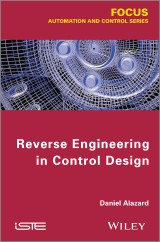Details

Reverse Engineering in Control Design
1. Aufl.
|
139,99 € |
|
| Verlag: | Wiley |
| Format: | EPUB |
| Veröffentl.: | 05.03.2013 |
| ISBN/EAN: | 9781118602621 |
| Sprache: | englisch |
| Anzahl Seiten: | 192 |
DRM-geschütztes eBook, Sie benötigen z.B. Adobe Digital Editions und eine Adobe ID zum Lesen.
Beschreibungen
<p>Reverse Engineering in Control Design proposes practical approaches to building a standard H-infinity problem taking into account an initial controller. Such approaches allow us to mix various control objectives and to initialize procedures for a fixed-structure controller design. They are based on the Observer-Based Realization (OBR) of controllers. The interest of OBR from the controller implementation point of view is detailed and highlighted in this book through academic examples. An open-source toolbox is available to implement these approaches in Matlab®.<br /> Throughout the book academic applications are proposed to illustrate the various basic principles. These applications have been chosen by the author for their pedagogic contents and demo files and embedded Matlab® functions can be downloaded so readers can run these illustrations on their personal computers.</p> <p>Contents</p> <p>1. Observer-based Realization of a Given Controller.<br /> 2. Cross Standard Form and Reverse Engineering.<br /> 3. Reverse Engineering for Mechanical Systems.<br /> Appendix 1. A Preliminary Methodological Example.<br /> Appendix 2. Discrete-time Case.<br /> Appendix 3. Nominal State-feedback for Mechanical Systems.<br /> Appendix 4. Help of Matlab® Functions.<br /> <br /> </p> <p>About the Authors</p> <p>Daniel Alazard is Professor in System Dynamics and Control at Institut Supérieur de l'Aéronautique et de l’Espace (ISAE), Toulouse, France – SUPAERO Graduate Program. His main research interests concern robust control, flexible structure control and their applications to various aerospace systems.</p>
<p>NOMENCLATURE ix</p> <p>INTRODUCTION xi</p> <p><b>CHAPTER 1. OBSERVER-BASED REALIZATION OF A GIVEN CONTROLLER 1</b></p> <p>1.1. Introduction 1</p> <p>1.2. Principle 3</p> <p>1.3. A first illustration 9</p> <p>1.4. Augmented-order controllers 12</p> <p>1.5. Discussion 16</p> <p>1.6. In brief 19</p> <p>1.7. Reduced-order controllers case 20</p> <p>1.8. Illustrations 23</p> <p>1.8.1. Illustration 1: plant state monitoring 24</p> <p>1.8.2. Illustration 2: controller switching 26</p> <p>1.8.3. Illustration 3: smooth gain scheduling 29</p> <p>1.9. Reference inputs in observer-based realizations 31</p> <p>1.9.1. General results 31</p> <p>1.9.2. Illustration 33</p> <p>1.10. Disturbance monitoring and rejection 36</p> <p>1.10.1. General results 36</p> <p>1.10.2. Illustration 40</p> <p>1.11. Minimal parametric description of a linear system 44</p> <p>1.12. Selection of the observer-based realization 47</p> <p>1.12.1. Luenberger observer dynamics assignment 47</p> <p>1.12.2. State-estimator dynamics assignment 48</p> <p>1.13. Conclusions 49</p> <p>1.14. Bibliography 49</p> <p><b>CHAPTER 2. CROSS STANDARD FORM AND REVERSE ENGINEERING 53</b></p> <p>2.1. Introduction 53</p> <p>2.2. Definitions 55</p> <p>2.3. Low-order controller case (nK ≤ n) 56</p> <p>2.3.1. Uniqueness condition 58</p> <p>2.3.2. Existence of a CSF 59</p> <p>2.4. Augmented-order controller case (nK > n) 61</p> <p>2.5. Illustration 61</p> <p>2.5.1. Solving the inverse H∞-optimal control problem 61</p> <p>2.5.2. Improving K0 with frequency-domain specification 64</p> <p>2.5.3. Improving K0 with phase lead 66</p> <p>2.6. Pseudo-cross standard form 69</p> <p>2.6.1. A reference model tracking problem 69</p> <p>2.6.2. Illustration 70</p> <p>2.6.3. Comment 72</p> <p>2.7. Conclusions 72</p> <p>2.8. Bibliography 73</p> <p><b>CHAPTER 3. REVERSE ENGINEERING FOR MECHANICAL SYSTEMS 77</b></p> <p>3.1. Introduction 77</p> <p>3.2. Context 78</p> <p>3.3. Model, specifications and initial controller 79</p> <p>3.4. H∞ design based on the acceleration sensitivity function 81</p> <p>3.4.1. General results 81</p> <p>3.4.2. Illustration 84</p> <p>3.4.3. Analysis on an augmented model 88</p> <p>3.4.4. Illustration 88</p> <p>3.4.5. Synthesis on an augmented model 89</p> <p>3.4.6. Illustration 91</p> <p>3.4.7. Taking into account a roll-off specification 94</p> <p>3.4.8. Illustration 96</p> <p>3.4.9. Taking into account an integral term 98</p> <p>3.4.10. Illustration 100</p> <p>3.5. Mixed H2/H∞ design based on the acceleration sensitivity function 102</p> <p>3.5.1. The one degree of freedom case 103</p> <p>3.5.2. First-order optimality conditions 106</p> <p>3.5.3. Numerical solution using Matlab® 118</p> <p>3.5.4. Multi-variable case 120</p> <p>3.6. Aircraft lateral flight control design 121</p> <p>3.6.1. Model and specifications 121</p> <p>3.6.2. Basic H2/H∞ control problem 123</p> <p>3.6.3. Augmented H∞ control problem 126</p> <p>3.7. Conclusions 130</p> <p>3.8. Bibliography 131</p> <p>CONCLUSIONS AND PERSPECTIVES 135</p> <p><b>APPENDICES 139</b></p> <p>Appendix 1. A Preliminary Methodological Example 141</p> <p>Appendix 2. Discrete-time Case 149</p> <p>Appendix 3. Nominal State-feedback for Mechanical Systems 153</p> <p>Appendix 4. Help of Matlab® Functions 159</p> <p>LIST OF FIGURES 169</p> <p>INDEX 175</p>
<p><strong>Daniel Alazard</strong> is Full Professor at ISAE, Toulouse, France.


















